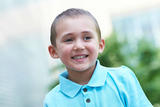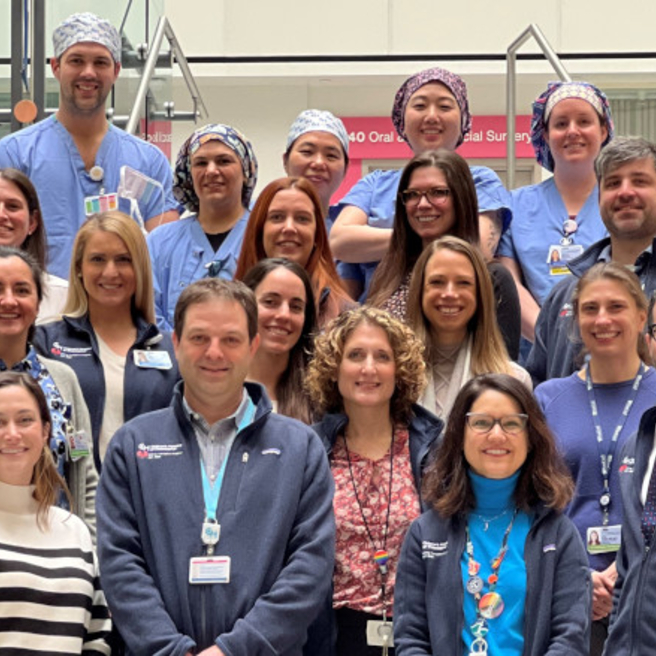What is non-Hodgkin lymphoma?
Lymphomas, both non-Hodgkin and Hodgkin lymphoma, are the third most common cancer in children. Non-Hodgkin lymphoma in children (NHL) can occur at any time during life, but is most common in younger children. Hodgkin lymphoma is more common in adolescents. There is no known cause of lymphoma in children.
The term lymphoma refers to a group of cancers of the lymph system, which is made up of:
- Lymph nodes, or glands, which are located throughout the body and hold groups of infection-fighting white blood cells
- Organs such as lymph nodes, the spleen and the thymus which produce and store infection-fighting cells
- Other body areas that have collections of white blood cells within them, such as the tonsils, stomach, small intestine and skin
In non-Hodgkin lymphoma, early white blood cells called lymphoblasts grow out of control and fail to mature. These cells, which make up the lymphoma, increase in number, causing swelling or enlargement of the glands or other body areas where they are usually found. This is why a child with lymphoma might have swollen lymph glands or a swollen abdomen.
Lymphoma cells may also be present in the spinal fluid, which surrounds the brain and spinal cord. In boys, lymphoma cells can hide in the testes, making them swollen. The disease may also involve the bone marrow, which is the soft part in the center of the bones where blood cells are made.
Types of non-Hodgkin lymphoma in children
There are three major types of non-Hodgkin lymphoma found in children:
- Mature B cell lymphoma involves the B lymphocytes of the immune system. These lymphomas make up about 40 percent of non-Hodgkin lymphoma cases. There are two slightly different forms of mature B cell lymphoma seen in children, Burkitt’s lymphoma (BL) and Diffuse Large B Cell Lymphoma (DLBCL). Children with this type of non-Hodgkin lymphoma usually have enlarged lymph nodes in the throat, neck or in the abdomen. Sometimes these lymphomas can be found in the bones or bone marrow.
- Anaplastic Large Cell Lymphoma (ALCL) . This lymphoma can occur in lymph nodes or glands, but also can occur in other body areas such as bones or organs. ALCL is also sometimes seen as a rash or lumps in the skin. About 10 percent of childhood NHL is caused by ALCL.
- Lymphoblastic lymphoma (LL) accounts for about 30 percent of NHL in children. This lymphoma can involve either T cells or B cells. LL can cause swollen lymph nodes or glands in any part of the body. Some children with LL may have very swollen nodes that form a large mass in the center of the chest (an area called the mediastinum). LL can also invade the bone marrow or spinal fluid.
Signs and symptoms of non-Hodgkin lymphoma in children
Non-Hodgkin lymphoma may start and grow slowly, but more often seems to grow quickly. Symptoms vary depending on what group of lymph nodes is affected.
The first symptoms in your child may be large swollen glands in the neck, chest, under the arms, or in the groin. Swollen lymph glands in the neck and chest may cause a cough, shortness of breath, wheezing, or swelling of the face. Some children may experience fevers, pale skin, rashes, or decreased appetite.
When non-Hodgkin lymphoma begins in the abdomen, early symptoms may include stomach pain, a change in bowel habits, or a mass (tumor) in the abdomen.
Diagnosis of non-Hodgkin lymphoma in children
Your child will undergo several or all of the following diagnostic tests to determine the exact diagnosis, and to see which areas of the body may be affected by the lymphoma.
- Surgical biopsy. A sample of the abnormal issue is removed and examined in the laboratory to make a diagnosis of non-Hodgkins lymphoma. The sample of tissue is removed while your child is under general anesthesia.
- Bone marrow aspirate and biopsy. Bone marrow is removed from the hip bone with a needle, and sent to the laboratory for special tests.
- X-rays. X-rays of the chest help find enlarged lymph nodes inside the chest
- Blood tests. Complete blood count (CBC) and blood chemistries are done to look for evidence of disease and any possible effects on other organs of the body such as the kidney or liver
- Ultrasound. This imaging test helps to find areas involved with lymphoma inside the abdomen, and pelvic area.
- CT scan. A picture of the neck, chest, abdomen and/or pelvis is taken to look for the spread/extent of disease. The test uses an X-ray machine and a computer. Depending on the reason for the CT scan, a contrast solution may be injected through a vein and/or a liquid contrast may be given to drink.
- PET CT. This test uses a very slightly radioactive sugar compound to search for actively growing sites inside the body, and uses a CT scan to locate exactly which body part is affected. It can be helpful in finding hidden areas of lymphoma.
- EKG-Echo (Electrocardiogram and Echocardiogram). These tests determine heart function prior to treatment.
- Pulmonary function tests. These tests determine lung function prior to treatment.
Treatment of non-Hodgkin lymphoma in children
The treatment of non-Hodgkin lymphoma in children depends on the exact type of lymphoma involved, and the extent of the disease or stage of the lymphoma.
After the diagnosis of non-Hodgkin lymphoma is made and test results are in, the medical team will discuss the results with you at a family meeting. Your child's doctor will discuss the treatment plan for your child.
Your child's treatment plan will include chemotherapy (drugs that kill cancer cells) and sometimes radiation therapy. You will be given a roadmap (a treatment schedule for your child). We will help you learn about the different chemotherapy drugs that will be given to your child. If indicated, you will be given information about radiation therapy as well.
Your child's chemotherapy will be given either during an inpatient hospital stay or in the Oncology Outpatient Clinic. Radiation treatments, including proton therapy, will be given on an outpatient basis, usually at the Roberts Proton Therapy Center at the Hospital of the University of Pennsylvania (across the street from Children’s Hospital).
Follow-up studies and scans will be done to see how your child’s lymphoma has responded to the treatment. We will attempt to schedule these as conveniently as possible, along with your usual clinic appointments.
During your child's hospitalization and your visits to the Oncology Clinic, the doctors, nurses, and social workers will be working with you and your child to understand your child's disease, its treatment, and how to care for his/her special needs at home. The Oncology staff is always available in person or by phone to answer any questions or concerns you might have about your child and how he or she is reacting to the treatments.
Although Non-Hodgkin lymphoma is a disease that is serious and potentially life-threatening (as are all forms of cancer), much success has been seen with the treatment of this disease and most children can be cured of their lymphoma.

Get a Second Opinion from CHOP
Our experts are here to review your child's diagnosis and treatment plan, and work with primary oncologists as needed
Late effects/cancer survivorship
Some children treated for non-Hodgkin lymphoma may develop complications of the treatment as they grow up. Our Cancer Survivorship Program provides information about the potential long-term effects of the specific treatment your child received, including ways of monitoring and treating these effects.
Resources to help
Non-Hodgkin Lymphoma in Children Resources
Leukemia and Lymphoma Program Resources
We have created resources to help you find answers to your questions and feel confident with the care you are providing your child at home.


